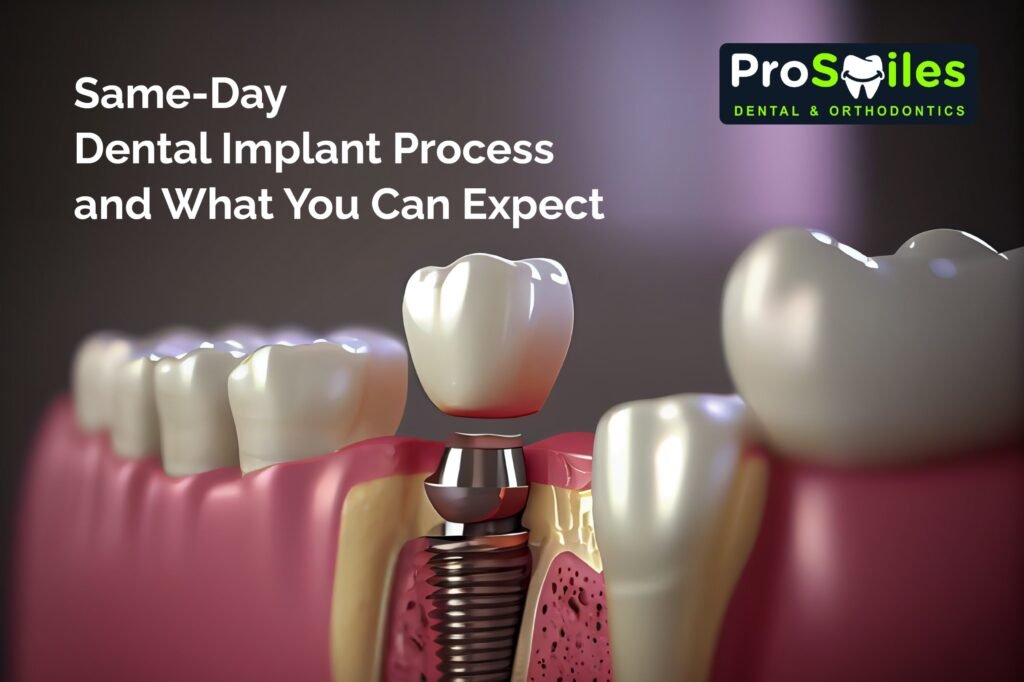Same-day dental implants have become one of the most effective and popular solutions for replacing missing teeth. Traditionally, getting dental implants required multiple visits over several months, with patients having to wait for their implants to fuse with the jawbone before getting the final prosthetic teeth. This innovative procedure is not only convenient but also helps patients regain their smiles faster.
In this blog, we’ll provide a detailed overview of the same-day dental teeth implant process, covering how it works, who qualifies for it, what the procedure entails, and what to expect during recovery.
What are one-day tooth implants?
Same-day dental implants also referred to as immediate-load implants or dental implants in one day, are a dental solution where a patient’s missing tooth (or teeth) can be replaced with a temporary crown, bridge, or denture on the same day the implant is placed. The key difference between traditional implants and same-day implants is the timeframe. While traditional implants require a waiting period of 3 to 6 months for osseointegration (the process where the implant fuses with the bone), same-day implants place a temporary restoration on the same day, allowing patients to leave the dentist’s office with a functional and aesthetic replacement teeth in one day.
How Does the Same-Day Dental Implant Process Work?
Although same-day implants are a faster solution, the planning and precision involved are meticulous. Here’s a breakdown of the steps in the process:
Initial Consultation and Assessment
Before the one-day tooth implant procedure can be performed, you’ll need to undergo a comprehensive dental examination to determine whether you’re a good candidate. This initial consultation typically includes:
X-rays and 3D scan
The dentist will take detailed images of your teeth, gums, and jawbone using advanced imaging technology like CBCT (Cone Beam Computed Tomography) scans. These 3D scans provide highly accurate images of your bone structure, ensuring the dentist can plan the precise placement of the implant.
Oral health evaluation
Your dentist will assess your oral health, checking for signs of gum disease or infections, and determining whether your jawbone is healthy and dense enough to support an implant. This is crucial because a strong jawbone is needed to secure the implant properly.
Medical history review
Your overall health will also be evaluated, as certain medical conditions (like uncontrolled diabetes or heart issues) or habits (like smoking) affect the healing process.
If you’re deemed a good candidate, the dentist will create a customized treatment plan, mapping out the placement of the implant and the type of restoration (crown, bridge, or denture) that will be attached.
The process of tooth extraction and restoration
Experienced dentists can perform tooth extraction and implants on the same day. If you have a damaged or decayed tooth that needs to be replaced, the dentist may extract the tooth as part of the implant procedure.
Thanks to modern techniques, tooth extractions are relatively quick and minimally invasive, and in many cases, the implant can be placed directly into the socket where the tooth was removed.
Placement of the Dental Implant
Once the extraction (if needed) is complete, the dental implant will be placed into the jawbone. The implant is a small titanium post that acts as the root of your new tooth. Titanium is used because of its biocompatibility, which means it can bond with the bone in a process called osseointegration.
Here’s how the implant placement works:
Anesthesia: To ensure the procedure is painless, local anesthesia is administered to numb the area. Sedation options are also available for patients who feel anxious.
Drilling: A small incision is made in the gum, and a specialized dental drill is used to create a space in the jawbone where the implant will be placed.
Implant Insertion: The titanium implant is carefully placed into the prepared bone socket. Precision is key to ensure that the implant is positioned correctly for stability and function.
Immediate Load: Unlike traditional implants, where you’d wait for the implant to fuse with the bone before attaching a restoration, a temporary crown, bridge, or denture is placed immediately onto the implant. This temporary prosthetic will allow you to chew, speak, and smile with confidence while the implant heals.
The Placement of the Temporary Restoration: The temporary restoration (crown, bridge, or denture) is placed on top of the implant right after it’s inserted. These temporary teeth are designed to be functional but aren’t as strong as permanent restorations. They allow the implant to heal and integrate with the jawbone without placing too much pressure on the area.
It’s essential to follow your dentist’s post-operative instructions to avoid overloading the implant, which could hinder the healing process.
The follow-up and permanent restoration
After several months (usually 3 to 6 months), once the implant has fully integrated with the bone, you’ll return to the dentist for the final step.
During this appointment, the following procedures will take place:
- Temporary crown removal: The temporary restoration is removed.
- Permanent restoration: A custom-made permanent crown, bridge, or denture is attached to the implant. These are designed to look and feel like your natural teeth, blending seamlessly with your smile.
Who is a Candidate for Same-Day Dental Implants?
Same-day dental implants are not suitable for everyone. You might be a good candidate if:
- You have good overall oral health: Healthy gums and sufficient jawbone density are critical for successful implant placement.
- You’re missing one or more teeth: Same-day implants can be used for single-tooth replacements, multiple teeth, or even full arch restorations.
- You don’t have bruxism: If you grind or clench your teeth excessively, you may not be a candidate for same-day implants, as this can put too much pressure on the implant before it fully heals.
- You’re a non-smoker: Smoking can slow down the healing process and increase the risk of implant failure. Smokers may need to quit or reduce smoking before considering implants.
- Patients with underlying health conditions (such as uncontrolled diabetes or autoimmune diseases) may not qualify for same-day implants but can still be eligible for traditional dental implants after addressing any health concerns.
Recovery and Aftercare for Same-Day Dental Implants
Although same-day implants offer immediate results, proper aftercare is critical for ensuring successful healing and long-term results. Here’s what to expect during the recovery process:
Post-Procedure Care: After the surgery, you may experience some swelling, tenderness, and mild discomfort. Your dentist may prescribe pain medications or recommend over-the-counter pain relievers to manage these symptoms.
Diet: For the first few days, stick to a soft-food diet to avoid putting too much pressure on the new implant. Gradually reintroduce firmer foods as your implant heals.
Oral Hygiene: It’s essential to maintain good oral hygiene by brushing and flossing carefully around the implant area. Your dentist may recommend using a special mouthwash to prevent infection.
Follow-Up Appointments: Regular follow-up appointments will be scheduled to monitor the healing process and ensure the implant is integrating properly.
Same-day dental implants are a game-changing option for individuals looking for a fast, efficient, and reliable solution to tooth loss. By allowing patients to leave the dentist’s office with a functional and aesthetically pleasing temporary tooth on the same day as implant placement, this procedure offers immediate benefits without compromising long-term results. If you’re looking for a reliable dental office to get your dental implants in one day, reach out to us at ProSmiles!




